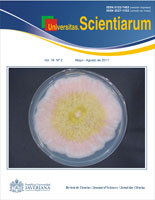Abstract
We described the feeding behavior of Central-American black howler monkey (Alouatta pigra) in a fragment of less than one hectare of humid evergreen forest surrounded by grassland for livestock use, isolated trees and mango orchards, in the region of Balancán (Tabasco, México). Objective: To record the diet and activity of black howler monkeys in crowded conditions during the wettest month in Balancán (Tabasco, México). Methods: The behavioral observations (81 h) were made using the focal animal methodology with an A. pigra troop made up of three individuals (1 adult male, 1 adult female and 1 infant). Results: Feeding time represented 15.97%, rest 78% and locomotion 4.57% of total time. In the study area we recorded 14 plant species, with 10 being consumed by howler monkeys. 55% of feeding time was devoted to the consumption of fruits, 27% to leaves, 17% to stems, and 1% to sprouts. Spondias mombin was the tree species most consumed, with 61% of the time invested on it. Conclusion: Like other studies, we confirmed the frugivore-folivore feeding tendency of the genus Alouatta. We provide information on the black howler monkey flexibility to live and maintain themselves in extreme perturbation conditions, where their habitat is 0.1 ha with few tree species to use, forcing individuals to move around the ground.
Key words: Alouatta pigra, diet, pattern of activity, frugivory, fragmented habitat
Univ. Sci. is registered under a Creative Commons Attribution 4.0 International Public License. Thus, this work may be reproduced, distributed, and publicly shared in digital format, as long as the names of the authors and Pontificia Universidad Javeriana are acknowledged. Others are allowed to quote, adapt, transform, auto-archive, republish, and create based on this material, for any purpose (even commercial ones), provided the authorship is duly acknowledged, a link to the original work is provided, and it is specified if changes have been made. Pontificia Universidad Javeriana does not hold the rights of published works and the authors are solely responsible for the contents of their works; they keep the moral, intellectual, privacy, and publicity rights. Approving the intervention of the work (review, copy-editing, translation, layout) and the following outreach, are granted through an use license and not through an assignment of rights. This means the journal and Pontificia Universidad Javeriana cannot be held responsible for any ethical malpractice by the authors. As a consequence of the protection granted by the use license, the journal is not required to publish recantations or modify information already published, unless the errata stems from the editorial management process. Publishing contents in this journal does not generate royalties for contributors.



